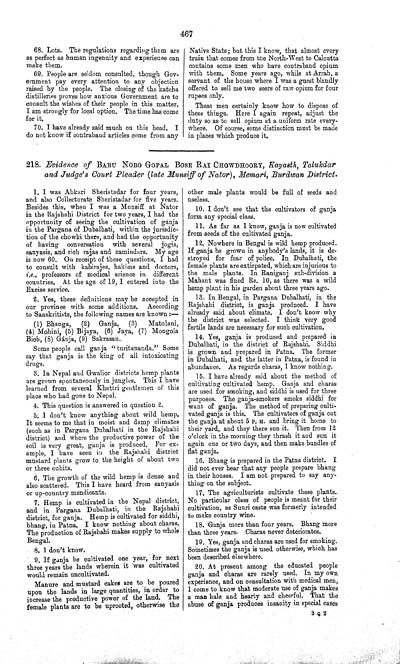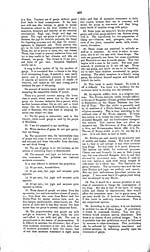Medicine - Drugs > Report of the Indian Hemp Drugs Commission, 1894-1895 > Volume IV
(481) Volume 4, Page 467
Thumbnail gallery: Grid view | List view

467
68. Lots. The
regulations regarding them are
as perfect as human ingenuity and experience can
make them.
69. People are
seldom consulted, though Gov-
ernment pay every attention to any objection
raised by the people. The closing of the katcha
distilleries proves how anxious Government are to
consult the wishes of their people in this matter.
I am strongly for local option. The time has come
for it.
70. I have already
said much on this head. I
do not know if contraband articles come from any
Native State; but
this I know, that almost every
train that comes from the North-West to Calcutta
contains some men who have contraband opium
with them. Some years ago, while at Arrah, a
servant of the house where I was a guest blandly
offered to sell me two seers of raw opium for four
rupees only.
These men certainly know
how to dispose of
these things. Here I again repeat, adjust the
duty so as to sell opium at a uniform rate every-
where. Of course, some distinction must be made
in places which produce it.
218. Evidence of
BABU NOBO GOPAL BOSE RAI CHOWDHOORY, Kayasth, Talukdar
and Judge's Court
Pleader (late Munsiff of Nator), Memari, Burdwan
District.
1. I was Abkari
Sheristadar for four years,
and also Collectorate Sheristadar for five years.
Besides this, when I was a Munsiff at Nator
in the Rajshahi District for two years, I had the
opportunity of seeing the cultivation of ganja
in the Pargana of Dubalhati, within the jurisdic-
tion of the chowki there, and had the opportunity
of having conversation with several jogis,
sanyasis, and rich rajas and zamindars. My age
is now 60. On receipt of these questions, I had
to consult with kabirajes, hakims and doctors,
i.e., professors of medical science in different
countries. At the age of 19, I entered into the
Excise service.
2. Yes, these
definitions may be accepted in
our province with some additions. According
to Sanskritists, the following names are known:—
(1) Bhanga, (2) Ganja,
(3) Matulani,
(4) Mohini, (5) Bijaya, (6) Jaya, (7) Mongola
Bich, (8) Gánja, (9) Sakrasan.
Some people call ganja
"turitananda." Some
say that ganja is the king of all intoxicating
drugs.
3. In Nepal and
Gwalior districts hemp plants
are grown spontaneously in jungles. This I have
learned from several Khettri gentlemen of this
place who had gone to Nepal.
4. This question is answered in question 2.
5. I don't know
anything about wild hemp.
It seems to me that in moist and damp climates
(such as in Pargana Dubalhati in the Rajshahi
district) and where the productive power of the
soil is very great, ganja is produced. For ex-
ample, I have seen in the Rajshahi district
mustard plants grow to the height of about two
or three cubits.
6. The growth of
the wild hemp is dense and
also scattered. This I have heard from sanyasis
or up-country mendicants.
7. Hemp is
cultivated in the Nepal district,
and in Pargana Dubalhati, in the Rajshahi
district, for ganja. Hemp is cultivated for siddhi,
bhang, in Patna. I know nothing about charas.
The production of Rajshahi makes supply to whole
Bengal.
8. I don't know.
9. If ganja be cultivated
one year, for next
three years the lands wherein it was cultivated
would remain uncultivated.
Manure and mustard cakes
are to be poured
upon the lands in large quantities, in order to
increase the productive power of the land. The
female plants are to be uprooted, otherwise the
other male plants would be
full of seeds and
useless.
10. I don't see
that the cultivators of ganja
form any special class.
11. As far as I
know, ganja is now cultivated
from seeds of the cultivated ganja.
12. Nowhere in
Bengal is wild hemp produced.
If ganja be grown in anybody's lands, it is de-
stroyed for fear of police. In Dubalhati, the
female plants are extirpated, which are injurious to
the male plants. In Raniganj sub-division a
Mahant was fined Rs. 10, as there was a wild
hemp plant in his garden about three years ago.
13. In Bengal, in
Pargana Dubalhati, in the
Rajshahi district, is ganja produced. I have
already said about climate. I don't know why
the district was selected. I think very good
fertile lands are necessary for such cultivation.
14. Yes, ganja is
produced and prepared in
Dubalhati, in the district of Rajshahi. Siddhi
is grown and prepared in Patna. The former
in Dubalhati, and the latter in Patna, is found in
abundance. As regards charas, I know nothing.
15. I have already
said about the method of
cultivating cultivated hemp. Ganja and charas
are used for smoking, and siddhi is used for three
purposes. The ganja-smokers smoke siddhi for
want of ganja. The method of preparing culti-
vated ganja is this. The cultivators of ganja cut
the ganja at about 5 P. M. and bring it home to
their yard, and they there sun it. Then from 12
o'clock in the morning they thrash it and sun it
again one or two days, and then make bundles of
flat ganja.
16. Bhang is
prepared in the Patna district. I
did not ever hear that any people prepare bhang
in their houses. I am not prepared to say any-
thing on the subject.
17. The
agriculturists cultivate these plants.
No particular class of people is meant for their
cultivation, as Sunri caste was formerly intended
to make country wine.
18. Ganja more than
four years. Bhang more
than three years. Charas never deteriorates.
19. Yes, ganja and charas
are used for smoking.
Sometimes the ganja is used otherwise, which has
been described elsewhere.
20. At present among the
educated people
ganja and charas are rarely used. In my own
experience, and on consultation with medical men,
I come to know that moderate use of ganja makes
a man hale and hearty and cheerful. That the
abuse of ganja produces insanity in special cases
3 Q 2
Set display mode to: Large image | Zoom image | Transcription
Images and transcriptions on this page, including medium image downloads, may be used under the Creative Commons Attribution 4.0 International Licence unless otherwise stated. ![]()
| India Papers > Medicine - Drugs > Report of the Indian Hemp Drugs Commission, 1894-1895 > Volume IV > (481) Volume 4, Page 467 |
|---|
| Permanent URL | https://digital.nls.uk/74553212 |
|---|---|
| Description | Evidence of Bengal witnesses. |
| Description | Volume 4: Evidence of witnesses from Bengal and Assam. |
|---|---|
| Attribution and copyright: |
|




